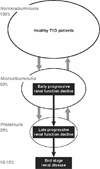High risk of ESRD in type 1 diabetes: new strategies are needed to retard progressive renal function decline
- PMID: 23062980
- PMCID: PMC3474985
- DOI: 10.1016/j.semnephrol.2012.07.002
High risk of ESRD in type 1 diabetes: new strategies are needed to retard progressive renal function decline
Abstract
Care of patients with type 1 diabetes (T1D) has changed during the past 30 years. Tools to control hyperglycemia have improved and it was shown that improvement in glycemic control diminished the risk of late diabetic complications, including nephropathy. Moreover, in patients with impaired renal function, aggressive treatment of hypertension and renoprotective blockade of the renin-angiotensin system were shown to postpone end-stage renal disease (ESRD), albeit for a short while. Despite these achievements, the incidence of ESRD caused by T1D in the US population has not decreased but rather has increased over the past 20 years, although it now occurs at slightly older ages. This state of affairs is a call to action. This should begin with adopting a new model of diabetic nephropathy in human beings. In that model, instead of microalbuminuria or proteinuria, the focus should be on diagnosis and treatment of progressive renal function decline that leads to ESRD. Such a model has received significant support in clinical and epidemiologic studies. Investigation of mechanisms of such progressive renal function decline should help in the identification of new therapeutic targets and the development of new interventions. To evaluate these interventions, accurate diagnostic algorithms are needed so T1D patients will be stratified according to time to onset to ESRD. Consistent with concepts of personalized medicine, the new interventions should be tailored to and evaluated in patients predicted to have rapid, moderate, or even slow progression to ESRD.
Copyright © 2012 Elsevier Inc. All rights reserved.
Figures






References
-
- Nawroth PP, Isermann B. Mechanisms of diabetic nephropathy – old buddies and newcomers part 1. Exp Clin Endocrinol Diabetes. 2010;118(9):571–576. - PubMed
-
- Nawroth PP, Isermann B. Mechanisms of diabetic nephropathy – old buddies and newcomers part 2. Exp Clin Endocrinol Diabetes. 2010;118(10):667–672. - PubMed
-
- Thomas MC. Pathogenesis and progression of proteinuria. Contrib Nephrol. 2011;170:48–56. - PubMed
-
- The Diabetes Control and Complications Trial Research Group. The effect of intensive treatment of diabetes on the development and progression of long-term complications in insulin-dependent diabetes mellitus. N Engl J Med. 1993;329:977–986. - PubMed
Publication types
MeSH terms
Substances
Grants and funding
LinkOut - more resources
Full Text Sources
Medical
Miscellaneous

